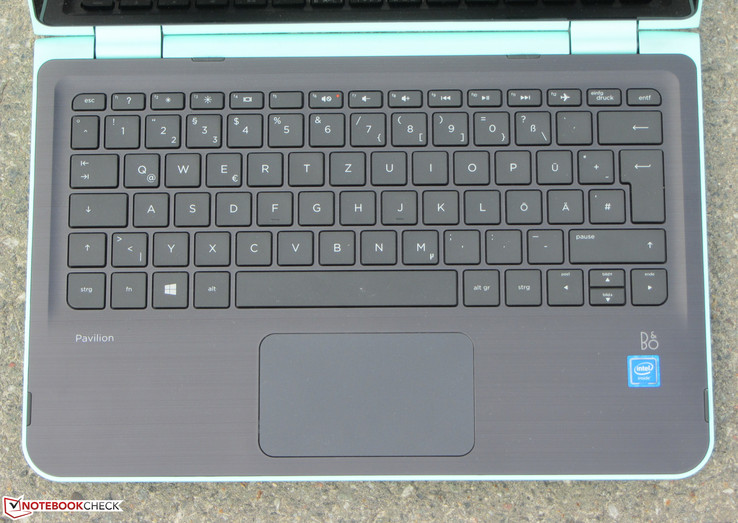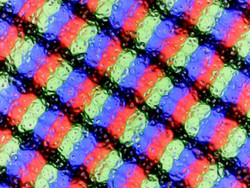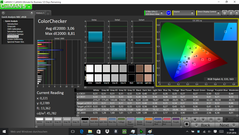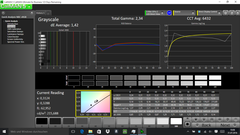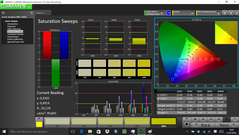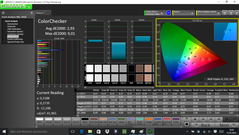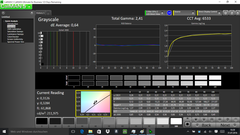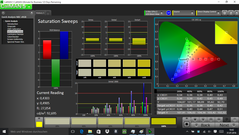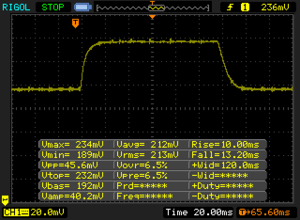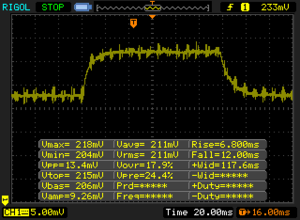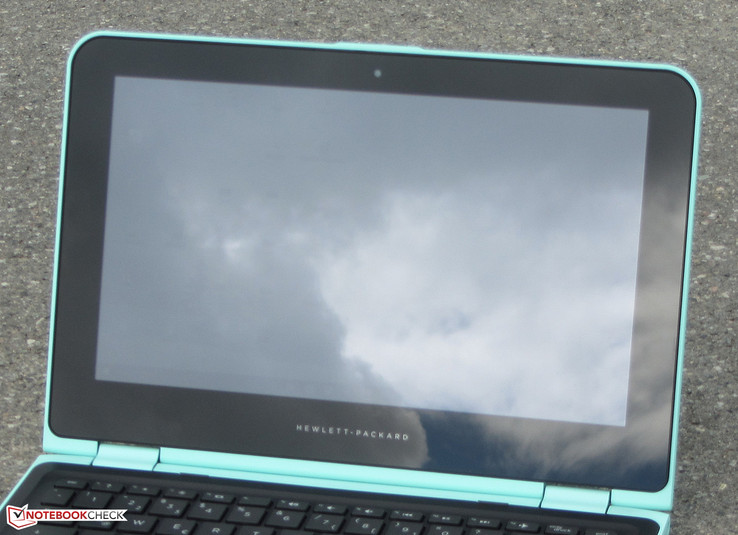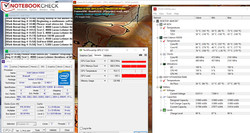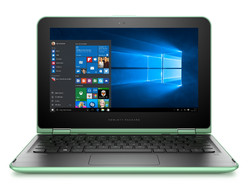HP Pavilion 11-k103ng x360 Convertible Review

For the original German review, see here.
Probably the most noticeable aspect of HP’s 11.6-inch convertible is the rather uncommon color: HP uses mint green, but you can also get it in red or silver. The device is powered by a Braswell processor. There is no shortage of competitors, including the Lenovo Yoga 300-11IBR, Toshiba Satellite Radius 11 L10W-C and the Asus Transformer Book Flip TP200SA.
Case & Connectivity
The Pavilion is a rather colorful device. You can get it in red, silver, and mint green, but not all parts of the plastic case are covered in these colors. The top of the base unit has a dark anthracite color and HP also tries to simulate brushed metal. The display frame on the other hand is black. Considering the price, there is not much to criticize when we evaluate the build quality of the system. One aspect is that the gaps are not always even, but the stability is completely acceptable in general.
You do not get a maintenance hatch, so you have to open the whole chassis to access the internals. All screws at the bottom have to be loosened, but you should note that there are additional screws underneath the rubber feet. After this, you can remove the top of the base unit. We recommend a sharp edge for this step. Attention: The top of the base unit is attached to the motherboard via two flat ribbon cables. Replacing the hard drive would be no problem at this point, but you would have to remove the whole motherboard to replace the 4 GB memory module with an 8 GB model.
There are no surprises when we look at the ports. Two of the three USB ports support the USB 3.0 standard, and all of them are regular Type-A ports. USB Type-C on the other hand is not available. HP only equips the convertible with a Fast-Ethernet port, which is common for many budget devices. Both the Ethernet as well as the WLAN chip are provided by Realtek (up to 72 Mbps gross). The measured transfer rates (in ideal conditions) are normal for this WLAN chip, but many users will probably want a faster module. Even modern Internet connections with 50 Mbps or more cannot be fully utilized.
The integrated card reader shows an average performance. We can measure 80.51 MB/s when we copy large files, and 250 jpg pictures (~5 MB each) are transferred at 45.6 MB/s. We check the performance of the card reader with our reference card from Toshiba (Exceria Pro SDXC 64 GB UHS-II).
Ports
| SD Card Reader | |
| average JPG Copy Test (av. of 3 runs) | |
| HP Pavilion 11-k103ng x360 | |
| HP x360 310 G1 | |
| Lenovo Yoga 300-11IBR | |
| maximum AS SSD Seq Read Test (1GB) | |
| HP x360 310 G1 | |
| HP Pavilion 11-k103ng x360 | |
| Lenovo Yoga 300-11IBR | |
| Networking | |
| iperf Server (receive) TCP 1 m | |
| HP x2 210 G1 | |
| iperf Client (transmit) TCP 1 m | |
| Toshiba Portege Z20t-C-121 | |
| HP x2 210 G1 | |
Input Devices
HP equips the Pavilion with a non-illuminated chiclet keyboard. The flat and slightly roughened keys have a short travel and a well-defined pressure point. Only the resistance could be a tad firmer – but this is a matter of taste. There is only minor bouncing during typing, and it was not annoying. All in all, HP implements a keyboard that is perfectly fine for day to day tasks. The ClickPad with multi-touch support is roughly 9.5 x 5.5 cm, so there is sufficient space for gestures. The smooth surface of the pad provides good gliding capabilities. The pad itself has a short travel and a distinct pressure point. We did not experience any problems with the touchscreen and our inputs were quickly executed.
Display
The Pavilion is equipped with an 11.6-inch touchscreen and a native resolution of 1366x768 pixels. We are not convinced by the low luminance of the panel (186.1 cd/m²), because such a low value pretty much limits the device to indoor environments. The contrast ratio (882:1) on the other hand is decent. Positive: There is no PWM flickering at any brightness level.
| |||||||||||||||||||||||||
Brightness Distribution: 86 %
Center on Battery: 193 cd/m²
Contrast: 882:1 (Black: 0.22 cd/m²)
ΔE ColorChecker Calman: 3.06 | ∀{0.5-29.43 Ø4.78}
ΔE Greyscale Calman: 1.42 | ∀{0.09-98 Ø5}
67.56% sRGB (Argyll 1.6.3 3D)
42.98% AdobeRGB 1998 (Argyll 1.6.3 3D)
46.73% AdobeRGB 1998 (Argyll 3D)
67.8% sRGB (Argyll 3D)
45.21% Display P3 (Argyll 3D)
Gamma: 2.34
CCT: 6432 K
| HP Pavilion 11-k103ng x360 IPS, 1366x768 | HP x360 310 G1 TN, 1366x768 | Lenovo Yoga 300-11IBR TN LED, 1366x768 | Toshiba Satellite Radius 11 L10W-C-108 TN LED, 1366x768 | Asus Transformer Book Flip TP200SA-FV0108TS IPS, 1366x768 | |
|---|---|---|---|---|---|
| Display | -17% | -18% | -11% | -9% | |
| Display P3 Coverage (%) | 45.21 | 37.47 -17% | 36.86 -18% | 40.42 -11% | 41.33 -9% |
| sRGB Coverage (%) | 67.8 | 56.4 -17% | 55.4 -18% | 60.3 -11% | 62.3 -8% |
| AdobeRGB 1998 Coverage (%) | 46.73 | 38.71 -17% | 38.08 -19% | 41.82 -11% | 42.7 -9% |
| Response Times | -69% | -106% | -178% | -154% | |
| Response Time Grey 50% / Grey 80% * (ms) | 18.8 ? | 43 ? -129% | 58 ? -209% | 80 ? -326% | 63 ? -235% |
| Response Time Black / White * (ms) | 23.2 ? | 25 ? -8% | 24 ? -3% | 30 ? -29% | 40 ? -72% |
| PWM Frequency (Hz) | 396 ? | 50 ? | 190 ? | ||
| Screen | -161% | -107% | -106% | -12% | |
| Brightness middle (cd/m²) | 194 | 199 3% | 256 32% | 221 14% | 264 36% |
| Brightness (cd/m²) | 186 | 186 0% | 242 30% | 220 18% | 247 33% |
| Brightness Distribution (%) | 86 | 76 -12% | 89 3% | 90 5% | 90 5% |
| Black Level * (cd/m²) | 0.22 | 0.8 -264% | 0.68 -209% | 0.29 -32% | 0.27 -23% |
| Contrast (:1) | 882 | 249 -72% | 376 -57% | 762 -14% | 978 11% |
| Colorchecker dE 2000 * | 3.06 | 11.92 -290% | 8.87 -190% | 10.31 -237% | 3.75 -23% |
| Colorchecker dE 2000 max. * | 8.81 | 20.52 -133% | 14.35 -63% | ||
| Greyscale dE 2000 * | 1.42 | 12.92 -810% | 9.6 -576% | 11.17 -687% | 3.28 -131% |
| Gamma | 2.34 94% | 2.04 108% | 2.2 100% | 2.39 92% | 2.59 85% |
| CCT | 6432 101% | 13589 48% | 9857 66% | 12620 52% | |
| Color Space (Percent of AdobeRGB 1998) (%) | 42.98 | 36 -16% | 35 -19% | 39 -9% | 39 -9% |
| Color Space (Percent of sRGB) (%) | 67.56 | 56 -17% | 55 -19% | 60 -11% | 62 -8% |
| Total Average (Program / Settings) | -82% /
-120% | -77% /
-89% | -98% /
-96% | -58% /
-32% |
* ... smaller is better
Screen Flickering / PWM (Pulse-Width Modulation)
| Screen flickering / PWM not detected | ||
In comparison: 53 % of all tested devices do not use PWM to dim the display. If PWM was detected, an average of 8111 (minimum: 5 - maximum: 343500) Hz was measured. | ||
The colors of the display are already pretty good ex-works. We can only measure a DeltaE-2000 deviation of 3.06, so it just misses the target value (DeltaE smaller 3). Even better is the grayscale performance with a deviation of just 1.42. A calibration will only slightly improve these results.
Display Response Times
| ↔ Response Time Black to White | ||
|---|---|---|
| 23.2 ms ... rise ↗ and fall ↘ combined | ↗ 10 ms rise | |
| ↘ 13.2 ms fall | ||
| The screen shows good response rates in our tests, but may be too slow for competitive gamers. In comparison, all tested devices range from 0.1 (minimum) to 240 (maximum) ms. » 52 % of all devices are better. This means that the measured response time is worse than the average of all tested devices (20.2 ms). | ||
| ↔ Response Time 50% Grey to 80% Grey | ||
| 18.8 ms ... rise ↗ and fall ↘ combined | ↗ 6.8 ms rise | |
| ↘ 12 ms fall | ||
| The screen shows good response rates in our tests, but may be too slow for competitive gamers. In comparison, all tested devices range from 0.165 (minimum) to 636 (maximum) ms. » 31 % of all devices are better. This means that the measured response time is better than the average of all tested devices (31.6 ms). | ||
Performance
The HP Pavilion is an 11.6-inch convertible and the performance is sufficient for office and web tasks. Our test model retails for 350 Euros (~$390), but you can also get other configurations and colors.
Processor
Inside the Pavilion is Intel’s Celeron N3050 (Braswell) dual-core processor. This is one of the least powerful CPUs you can currently get from Intel. Its performance is sufficient for simple office and web applications. The device can be cooled passively thanks to the low TDP at just 6 Watts; and the Pavilion makes use of it. The processor has a nominal clock of 1.6 GHz, which can be increased to 2.16 GHz via Turbo Boost. The latter is utilized both on mains as well as battery power.
| JetStream 1.1 - Total Score | |
| Lenovo Yoga 300-11IBR | |
| HP Pavilion 11-k103ng x360 | |
System Performance
The system runs smoothly and without hiccups. The PCMark results are on the expected level for the performance of the SoC. It is possible to increase the system performance of the Pavilion by replacing the HDD with an SSD, so the system would be more responsive and the loading times would be reduced.
| PCMark 8 Home Score Accelerated v2 | 1545 points | |
Help | ||
| PCMark 8 - Home Score Accelerated v2 | |
| Lenovo Yoga 300-11IBR | |
| HP Pavilion 11-k103ng x360 | |
| HP x360 310 G1 | |
Storage Devices
The storage solution is a 2.5-inch hard drive provided by Hitachi. It runs at 5,400 rpm and has a storage capacity of 500 GB. The transfer rates are on the normal level for such a drive.
| HP Pavilion 11-k103ng x360 Hitachi Travelstar Z5K500 HTS545050A7E680 | HP x360 310 G1 Toshiba MQ01ABF050 | Lenovo Yoga 300-11IBR Seagate ST500LM000 Solid State Hybrid Drive | Toshiba Satellite Radius 11 L10W-C-108 Hitachi Travelstar Z5K500 HTS545050A7E680 | Asus Transformer Book Flip TP200SA-FV0108TS 32 GB eMMC Flash | |
|---|---|---|---|---|---|
| CrystalDiskMark 3.0 | -24% | 17% | -21% | 1586% | |
| Read Seq (MB/s) | 106 | 99.5 -6% | 118.9 12% | 84.2 -21% | 164.5 55% |
| Write Seq (MB/s) | 106.1 | 102.9 -3% | 117.2 10% | 84.5 -20% | 67.8 -36% |
| Read 512 (MB/s) | 33.53 | 34.45 3% | 38.89 16% | 24.65 -26% | 165.1 392% |
| Write 512 (MB/s) | 39.03 | 42.7 9% | 76 95% | 24.34 -38% | 89.7 130% |
| Read 4k (MB/s) | 0.407 | 0.439 8% | 0.474 16% | 0.361 -11% | 18.05 4335% |
| Write 4k (MB/s) | 1.026 | 0.013 -99% | 0.99 -4% | 0.863 -16% | 20.49 1897% |
| Read 4k QD32 (MB/s) | 0.898 | 0.851 -5% | 1.081 20% | 0.733 -18% | 32.15 3480% |
| Write 4k QD32 (MB/s) | 1.003 | 0.033 -97% | 0.724 -28% | 0.842 -16% | 25.44 2436% |
GPU Performance
Intel's HD Graphics GPU handles the graphics output. It supports DirectX 12 and runs with a core clock of up to 600 MHz. Compared to the Bay Trail processors we get much more performance – but we are still on a pretty low level in general. The Braswell GPUs are based on Intel’s Broadwell architecture, while the Bay Trail GPUs are based on the older Ivy Bridge architecture.
| 3DMark 11 Performance | 412 points | |
Help | ||
| 3DMark 11 - 1280x720 Performance GPU | |
| Lenovo Yoga 300-11IBR | |
| HP Pavilion 11-k103ng x360 | |
| Toshiba Satellite Radius 11 L10W-C-108 | |
| HP x360 310 G1 | |
Gaming Performance
The SoC is best suited for simple causal games, which are available in the Windows Store. Modern games like Rise of the Tomb Raider on the other hand cannot be played. Only a couple of titles will actually reach playable frame rates – at low resolutions and low graphics settings. One example would be the game Sims 4.
| low | med. | high | ultra | |
|---|---|---|---|---|
| BioShock Infinite (2013) | 16.2 | 8.3 | 6.9 |
Emissions & Energy
Temperature
The Pavilion executes our stress test similarly on mains and battery power. CPU (1.8 GHz) and GPU (520 MHz) start the test with comparatively high clocks, but they will drop continuously over the course of the test. After about 15 minutes, the CPU clock is at 1 GHz, and it will continue to drop to 500 MHz (CPU) and 360 MHz (GPU), respectively. The Pavilion gets warmer than other devices with more powerful CPUs while idling. This is the result of the passive cooling solution. We can measure more than 50 °C at one spot.
(±) The maximum temperature on the upper side is 44.6 °C / 112 F, compared to the average of 35.4 °C / 96 F, ranging from 19.6 to 60 °C for the class Convertible.
(-) The bottom heats up to a maximum of 53.1 °C / 128 F, compared to the average of 36.8 °C / 98 F
(+) In idle usage, the average temperature for the upper side is 31.7 °C / 89 F, compared to the device average of 30.3 °C / 87 F.
(+) The palmrests and touchpad are reaching skin temperature as a maximum (32.8 °C / 91 F) and are therefore not hot.
(-) The average temperature of the palmrest area of similar devices was 27.9 °C / 82.2 F (-4.9 °C / -8.8 F).
Speakers
The stereo speakers are located at the bottom of the device. They create a decent sound you can listen to for longer periods. It is possible to adjust the sound with the preloaded B&O software.
HP Pavilion 11-k103ng x360 audio analysis
(+) | speakers can play relatively loud (82.1 dB)
Bass 100 - 315 Hz
(±) | reduced bass - on average 11.7% lower than median
(±) | linearity of bass is average (14.3% delta to prev. frequency)
Mids 400 - 2000 Hz
(+) | balanced mids - only 3.8% away from median
(+) | mids are linear (6% delta to prev. frequency)
Highs 2 - 16 kHz
(+) | balanced highs - only 3.5% away from median
(+) | highs are linear (6.9% delta to prev. frequency)
Overall 100 - 16.000 Hz
(±) | linearity of overall sound is average (17.6% difference to median)
Compared to same class
» 34% of all tested devices in this class were better, 8% similar, 58% worse
» The best had a delta of 6%, average was 20%, worst was 57%
Compared to all devices tested
» 34% of all tested devices were better, 8% similar, 58% worse
» The best had a delta of 4%, average was 24%, worst was 134%
Frequency Comparison (Checkboxen select/deselectable!)
Graph 1: Pink Noise 100% Vol.; Graph 2: Audio off
Power Consumption
We cannot see any conspicuous results in our consumption measurements and the Pavilion is pretty much on par with comparable devices. We can measure up to 8.2 Watts while idling and up to 18.9 Watts during our stress test. The nominal output of the power adapter is 45 Watts.
| Off / Standby | |
| Idle | |
| Load |
|
Key:
min: | |
Battery Runtime
Our practical WLAN test simulates web browsing with the "Balanced" power profile, deactivated power-saving features and an adjusted display luminance of about 150 cd/m². The Pavilion manages a runtime of 4:46 hours.
| Battery runtime - WiFi v1.3 | |
| HP Pavilion 11-k103ng x360 | |
| HP x360 310 G1 | |
| Lenovo Yoga 300-11IBR | |
| Toshiba Satellite Radius 11 L10W-C-108 | |
Pros
Cons
Verdict
The HP Pavilion 11-k103ng x360 is a simple 11.6-inch convertible. The processor is powerful enough for simple office and web applications, and you can also use it as a silent video player for a nearby TV. The GPU has an integrated decoder, which will take load of the processor. There is no shortage of storage space thanks to the 500 GB hard drive. It is also possible to replace it with an SSD, but that would require opening the case. The keyboard is sufficient in practice. We are not impressed by the battery runtime, because the Pavilion only lasts for 4:46 hours during our WLAN test – not enough for a compact and not really powerful device. The screen convinces with wide viewing angles and good contrast, but it is unfortunately too dark.
HP’s convertible is primarily designed for use on your couch, much more is not possible because of the battery runtimes and the dark screen.
You can get the Pavilion for around 350 Euros (~$390). Considering the features and the performance, we think the price is a bit too high. You should not pay more than 300 Euros (~$334) for it.
HP Pavilion 11-k103ng x360
- 08/08/2016 v5.1 (old)
Sascha Mölck






